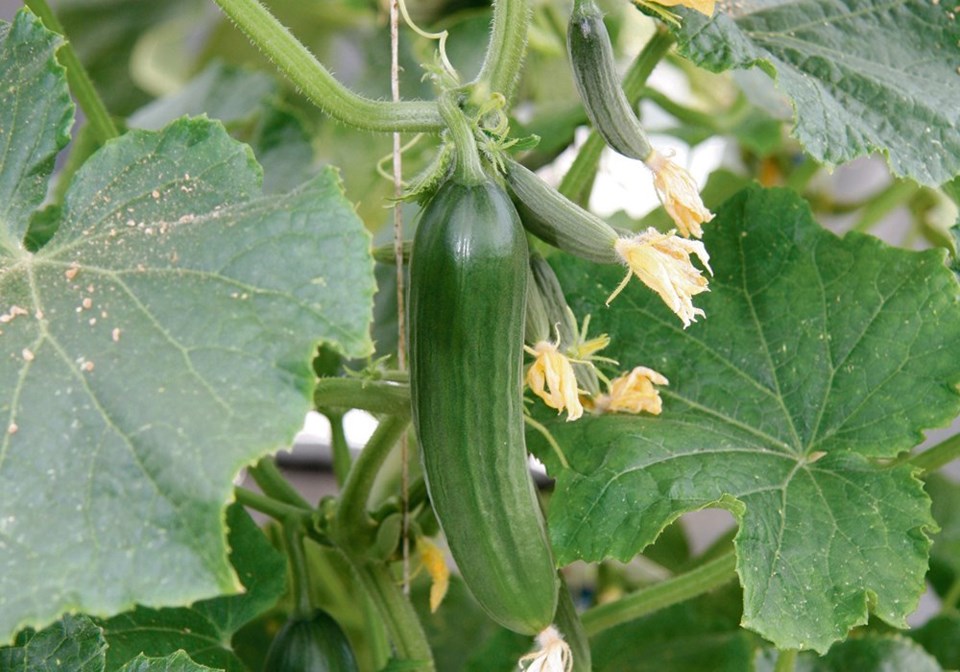OUTLOOK — Cucumbers are proving to be a promising crop under irrigation in Saskatchewan.
Previous research has shown that growers can produce pickling cucumbers suitable for retail sale.
The challenge now is to extend the harvest to better serve the retail market.
Doug Waterer, the former vegetable specialist at the University of Saskatchewan and now a consultant, conducted work at the irrigation centre in Outlook on optimal harvesting time.
“Because labour is so expensive, in Saskatchewan the only way this crop is going to work on a commercial scale was if it was mechanically harvested,” he told a field day late last year. “The problem is it’s a one-shot deal. You have to make sure that the field is at exactly the peak in terms of its yield but also in terms of size profile of the cucumbers that are on the plant.”
Small cucumbers are valuable, but don’t equate to tonnage, Waterer said, and management is required to balance the two.
The study at the irrigation centre in Outlook looked at sequential planting to extend the harvest while maintaining the smaller, more valuable vegetable.
Waterer said early on in the project they found they were living under a misconception, believing that a cucumber would set fruit, reach a certain stage and then set more fruit.
But that didn’t happen. Instead, the first couple of dominant fruit just keep growing.
“You can very quickly appreciate that they go from being nice, reasonably-sized pickling cucumber to a large gherkin, to something the size of a watermelon that’s completely unmarketable,” Waterer said.
The crop can go from its peak to an “unmarketable mess” within days.
Typically, there is a week to 10 days of optimal harvest timing from a cucumber crop before the fruit becomes too large and isn’t worth harvesting, he said.
But with a large investment in machinery, processing facilities and transportation, cucumber growers will need more than a one-week harvest.
Initially, the study looked at stretching the harvest window with different varieties. That extended it by about a week, he said.
The study, originally set to be two years but extended to three, moved on to different planting dates.
The first crop went in the ground the third week in May, or about as early as cucumbers can be planted without a frost risk.
The second planting was 10 days after that and the third another 10 days later, or about the third week in June. Any later and the crop could run into a fall frost.
Researchers found the first crop moved along and by the last week of July a 10-day harvest began. The final planting produced until early September.
Waterer said sequential planting worked well.
“We were able to put together a series of very, very high quality, high yielding harvests starting in the first week of August and actually continuing right through until the first week of September,” he said.
This type of production would provide a steady supply of cucumbers to a processor for a reasonable period of time.
Waterer said pollination is key when planting seeded cucumbers. At Outlook, there are honeybees close by. Another project used seedless varieties that don’t require pollinators.
He said it’s critical to walk fields and look at the size profiles of the cucumbers.
The cucumbers can reach the size of footballs and processors are uninterested in those, he said.
Asked if increased processing capacity would eliminate the need to stretch the harvest since once the cucumbers are pickled they are no longer perishable, Waterer said processors don’t want all the fruit all at once.
“Cucumbers are basically a ticking time bomb. Within 48 hours of them coming off the fields they have to be into the brine or else the quality starts to slip very, very quickly,” he said.
Although a dedicated processor hasn’t yet set up in the province there are locally produced pickles on co-op store shelves from growers involved in Prairie Fresh Food Corp.
Waterer said processors have indicated a minimum capacity of 500 acres is required.
Meanwhile, another project conducted at Outlook and the Conservation Learning Centre in Prince Albert looked at pollinator efficiency in cucumbers.
Graham Parsons, pollinator bio-security specialist at Saskatchewan Agriculture, said if the pickling cucumber business is to grow then commercially available pollinators will be required.
The one-year project compared three available species: bumble bee, honeybee and leafcutters.
Parsons said cucumbers have both male and female flowers on a single plant and require pollen transfer to set fruit.
But each of the species displays different foraging behaviour that could affect pollination success.
Bumble bees because of their size can forage when it’s fairly cool and windy and in low light and they will travel a fair distance, he said. Commercially available bumble bees are an emerging market.
Honeybees don’t like cooler temperatures but there are lots of them, said Parsons.
Leafcutter bees prefer 20 C or warmer and bright sunlight and only travel about 200 metres to forage.
The study measured fruit set, total weight, timing and quality of the fruit after open pollination, no pollination and controlled pollination by species.
In total weight at Outlook, all the pollinators did well compared to the plots where pollination was excluded, which would be expected.
“We had quite a bit of weight that was misshapen,” Parsons said, suggesting the plants in those cases had either been poorly pollinated or affected by the weather.
Bumble bees produced the most marketable cucumbers compared to misshapen.
The Prince Albert plots produced far more yield, likely a result of better pollination and bigger fruit, he said.
There was also more marketable fruit from each type of pollinator. The leafcutters produced the most marketable cucumbers, followed by honeybees and bumble bees.




